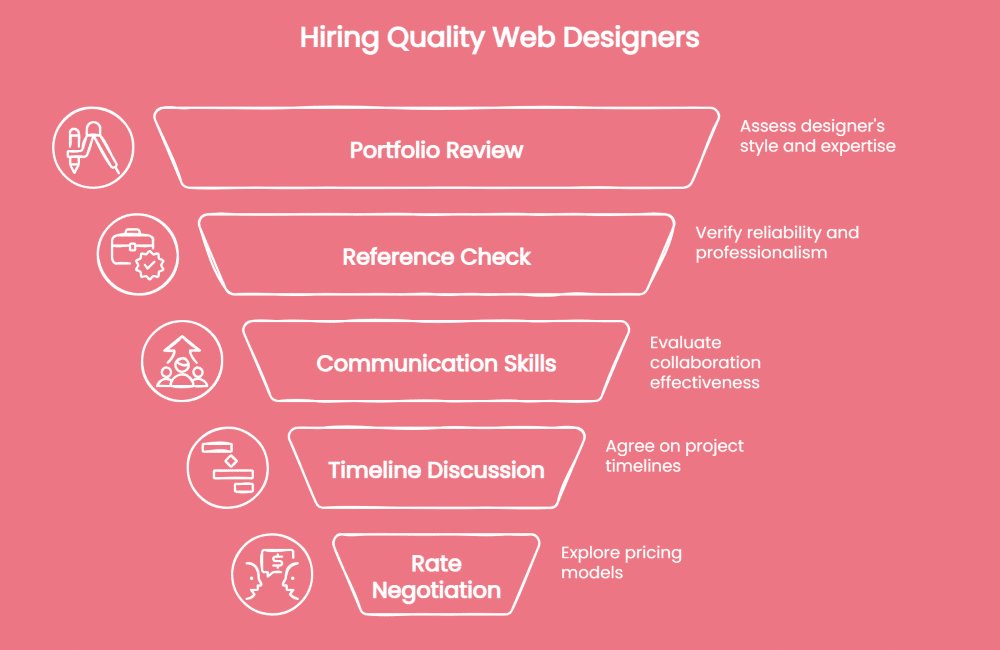TL;DR: Finding affordable web designers in Australia doesn’t mean compromising on quality. Smart businesses can secure professional web design services by understanding market rates ($2,000-$15,000 for small business sites), evaluating portfolios strategically, and choosing between freelancers, agencies, or DIY builders. Success lies in defining clear requirements, asking the right questions, and avoiding common pitfalls like choosing solely on price.
A professional website doesn’t have to come with a premium price tag.
Every Australian small business needs a professional website, but not everyone has a large budget. The good news is you can find quality web designers without breaking the bank.
Finding affordable web design services in Australia isn’t about settling for less. It’s about knowing the market, understanding what different options cost, and making choices that suit your business goals.
Whether you’re a startup in Sydney or a family-run business in Brisbane, working with professional designers within budget constraints is absolutely achievable.

How Much Does Web Design Cost in Australia?
Real numbers from the Australian market show what businesses can expect to spend:
- Simple 5-page site: $2,000–$5,000
- Standard business website: $5,000–$15,000
- Online store setup: $10,000–$30,000
- Custom applications: $20,000+
These figures cover local rates, where Australian designers generally charge $75–$200 per hour. By comparison, overseas developers can charge as little as $20–$40 an hour. While those savings look attractive, they often come with trade-offs in communication, time zones, and project timelines.
Local designers bring advantages that go beyond price: they understand Australian consumer behaviour, GST requirements, privacy laws, and what resonates with local audiences. A Sydney-based designer might deliver a $3,000 site in three weeks, while an offshore team quoting $1,000 could take three months with repeated revisions.
Choosing between local and international talent isn’t just about cost — it’s about value, efficiency, and the quality of the final result.
Tip 1: Define Your Budget and Requirements First
What Should I Budget for a Website in Australia?
Clarity transforms everything—especially negotiations.
Your website investment should match business objectives, not random figures. Service businesses often succeed with $3,000 information sites. Online retailers need $15,000+ e-commerce platforms for proper functionality.
Here’s your action plan:
List must-haves versus nice-to-haves immediately. Mobile responsiveness, contact forms, basic SEO? Essential. Custom animations, advanced booking systems? Phase two perhaps.
Don’t forget ongoing costs. Annual hosting runs $60-$500. Domain names cost $20-$50. Maintenance adds $500-$2,000 yearly. Plan accordingly.
Tip 2: Research Portfolio Quality Over Quantity
How Do I Evaluate a Web Designer’s Portfolio?
Volume means nothing without substance.
Fifty average websites don’t beat ten exceptional ones. Quality indicators matter more than quantity metrics ever will.
Test their portfolio sites yourself. Do pages load within three seconds? Check mobile versions on your phone. Feel dated or fresh?
Here’s what counts:
Find projects matching your industry needs. Restaurant website specialists might struggle with accounting firm requirements. Experience translates directly to results.
PRO Tip: Revisit portfolio sites after six months. Still updated? Ranking on Google? Long-term performance reveals true value beyond pretty screenshots.
Tip 3: Compare DIY Website Builders vs Professional Designers
Self-build versus professional help isn’t straightforward.
Wix, Squarespace, and WordPress.com tempt with $15-$50 monthly fees. Great for testing concepts or temporary pages during startup phases.
Hidden DIY costs include:
- Your time investment (30-100 hours minimum)
- Template limitations frustrating growth
- Thousands are using identical designs
- Weak SEO foundations
- Zero strategic guidance
Professional designers bring custom solutions, conversion knowledge, and technical expertise. They understand user psychology, purchase paths, and brand development deeply.
Bottom line? DIY suits hobbies. Professionals drive revenue.
Tip 4: Ask the Right Questions During Consultations
Strategic questions uncover everything important.
Skip generic price enquiries. Investigate their process, revision policies, and realistic timelines. Understanding workflow prevents nasty surprises.
Must-ask questions:
- “What’s specifically included in your quote?”
- “How many initial concepts will you present?”
- “Who retains design file ownership?”
- “What post-launch support exists?”
Watch for designers avoiding specifics or unable to explain processes clearly. Vagueness signals problems ahead.
Australian market experience matters significantly. Local knowledge impacts consumer targeting effectiveness dramatically.
Tip 5: Look for Transparent Pricing Models
Openness in pricing builds trust straight away. Successful projects begin with a clear breakdown of what’s included.
Professional quotes should detail:
- Design/development hours precisely
- Content creation or migration fees
- Plugin licensing costs
- Setup and configuration charges
- Training session allocation
Beware of vague “from $X” pricing without specifics. Fixed quotes protect both sides equally.
Payment plans can also make professional design more accessible — $500 monthly feels more manageable than a $6,000 lump sum.
Tip 6: Consider Freelancers vs Agencies
Business size doesn’t equal quality—alignment does.
Freelancers deliver personal attention, direct communication, and competitive pricing. You’re collaborating with the actual creator. Rates are typically 30-50% below agencies.
Agencies provide team depth, proven systems, and reliability. Freelancer’s illness halts progress. Agencies have contingencies ready.
Sweet spot discovery:
Boutique studios (2-5 people) blend personal service with team security. Often perfect for growing businesses needing both.
Match complexity to resources. Brochure sites suit solo freelancers. E-commerce platforms benefit from team expertise.
Tip 7: Evaluate Communication and Support
Response quality predicts everything.
Initial enquiry handling reveals future support standards. Week-long quote delays suggest nightmare post-launch experiences await.
Communication assessment checklist:
- Technical concepts explained clearly?
- Patient with beginner questions?
- Proactive suggestions offered?
Post-launch arrangements matter hugely. Understand warranty periods, change rates, and contact methods upfront.
Key Insight: Cheap becomes expensive when poor communication causes costly delays and mounting frustration.
Tip 8: Check Reviews and Get References
Authentic feedback reveals truth.
Google Reviews, Facebook recommendations, and LinkedIn testimonials expose real experiences. Read beyond ratings—study specific comments carefully.
Review red flags:
- Repeated deadline complaints
- Communication frustrations mentioned
- Surprise costs appearing
- Abandoned projects referenced
Request similar business references. Ask directly: “Delivered on schedule?” “Any hidden charges?” “Would you rehire?”
Previous clients usually share honestly, helping fellow business owners avoid mistakes.
Common Mistakes to Avoid When Hiring Budget Web Designers
Learning from common pitfalls can save time and money:
- Choosing based on price alone. Cheap builds often lead to expensive rebuilds later when problems surface.
- Skipping contracts. Always document scope, timelines, payments, and ownership — handshakes don’t hold up legally.
- Ignoring mobile users. With most visitors browsing on phones, responsive design should be standard, not an optional extra.
- Overlooking SEO basics. Without search-friendly foundations, even the best-looking site risks going unseen.
- Giving vague feedback. Comments like “make it pop” slow projects down. Be specific with colours, examples, and vision.
- Delaying content. Designers need text, images, and brand assets early. Procrastination here is a major cause of launch delays.
Other Practical Considerations
There are a few practical questions worth clarifying before you start a web design project:
- How long does a website take to build?
Simple sites can usually launch in 4–6 weeks. More complex functionality often takes 8–12 weeks or longer. - How are payments structured?
Expect a 25–50% deposit, milestone payments along the way, and final settlement on delivery. Avoid paying the full amount upfront. - Can I update the site myself?
With modern CMS platforms like WordPress, you should be able to edit content and make changes easily. Training should be part of your package. - What’s the difference between design and development?
Design is the look and feel of the site. Development handles the technical build. Many professionals cover both, but confirm this early. - Why is ongoing maintenance important?
Regular updates, backups, and security checks keep a site stable and secure. Budget at least $50–$200 per month.
Making the Smart Choice for Your Next Website
Affordable web design in Australia doesn’t mean cutting corners. With a clear budget, the right questions, and an understanding of the market, businesses can secure professional results without overspending. From avoiding common pitfalls to planning for long-term maintenance, the smartest investment is one that balances cost with quality.
At Spark, we help Australian businesses do exactly that — combining practical budgets with professional design and development. If you’re ready to build a website that works for your business today and supports growth tomorrow, our team is here to help.



